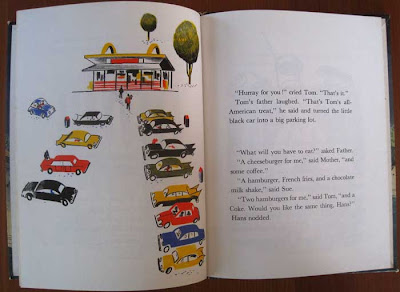A recent used bookstore find:

Look at that cover illustration closely -- there's no mention of McDonald's. The sign is very similar to ones in use around the time the book was published in 1965, but instead of "Wonderful Hamburgers," the signs read "McDonald's Hamburgers." What's the story here?

The anonymization continues inside with each wonderful cartoon modern illustration by Herb Ruud. (No biographical information seems to be available online about Ruud -- only mentions of books he illustrated.)
A boy named Tom gets to decide where his family (with their visiting German friend, Hans) will go to eat dinner. Tom's dense sister Sue tries to guess where they're going, and when she finally does after enough hints, Tom exclaims in dialogue that wouldn't have been typical for kids even in 1965, "Hurray for you!"

There was no indoor seating at McDonald's in those days, so mom and dad wait in the car while the kids go up to order the food. They never seem to pay for anything.
Dad tells Tom to ask for the manager, who can give them a tour of the place. I'm sure this happened all the time back in the day, right?

Watching the burgers being squirted with ketchup and mustard gives Tom a chance to tell Hans and Sue about good old American mass production, a common topic of conversation among children.

According to the book, this was a time when the potatoes were still peeled and sliced on-site, rather than being shipped in frozen. I guess they didn't have that mass production thing down perfectly yet.
As they eat their food in the car, Hans informs the family that hamburgers came from Russia via Germany, and Tom is disappointed that they aren't American. But dad comes to the rescue, telling everyone:
"On the contrary.... It is very American indeed. All Americans -- except the Indians -- have come from roots in other countries, bringing some of their culture with them and adapting their way of living to the new land, and so becoming Americans."Thus oversimplifying the fraught history of our country in the name of a vague oneness.
"And the earliest Indians came from Asia," said Mother.
It's not until the final page that the book is revealed (surprise!) to be about McDonald's. The book was a pretense to celebrate the 10th anniversary of McDonald's as a chain, and the story reflected that flimsy premise:

Across from one final nifty illustration, a different, smaller typeface is used to tell about McDonald's "Hamburger University," its clean kitchens and volume production methods.
I wonder if the books were given away at the restaurants, or sold there or elsewhere? Either way, the decision to obscure the brand name makes no sense, given the identification on the final page. What an odd little artifact of American culture!


2 comments:
I believe their first goal was to promote the idea of taking your family out for fast food. As the market leader, they stood to benefit from expanding the market overall. But they couldn't resist promoting their own firm in a big and obvious way. This is a funny artifact of the state of marketing in 1965.
That makes sense -- institutional advertising, I think it was called in Advertising 101. If Campbell's does an ad promoting soup in general, they are the ones who benefit the most from it, even if they don't name their brand.
Post a Comment